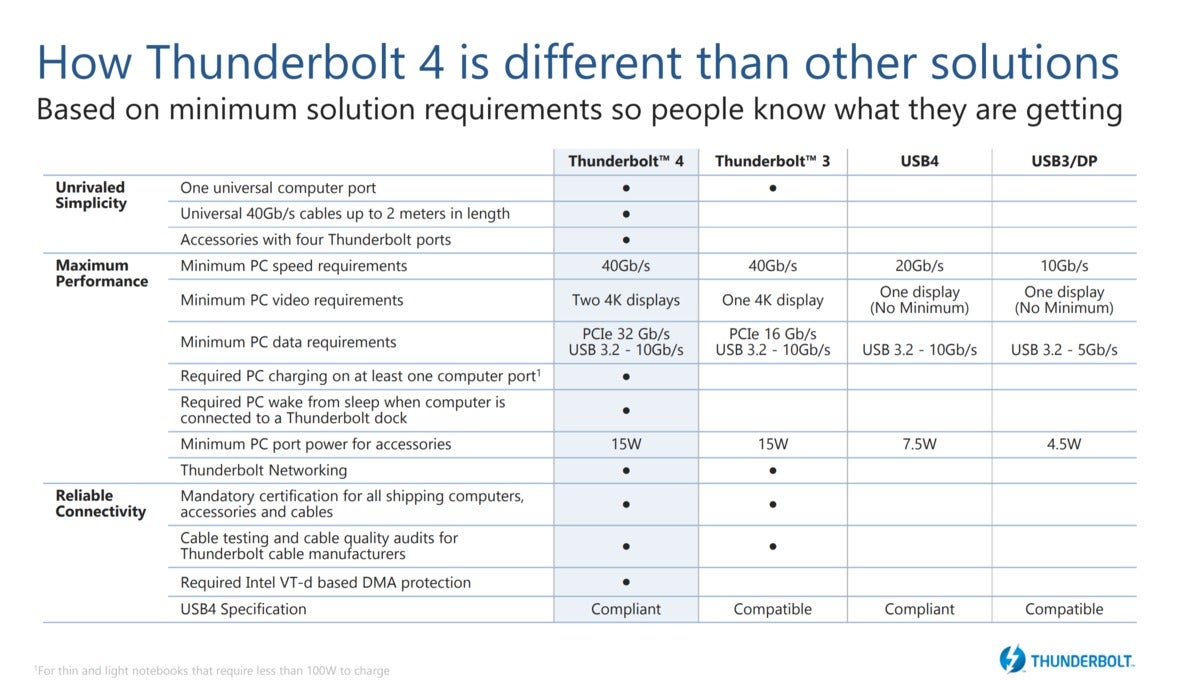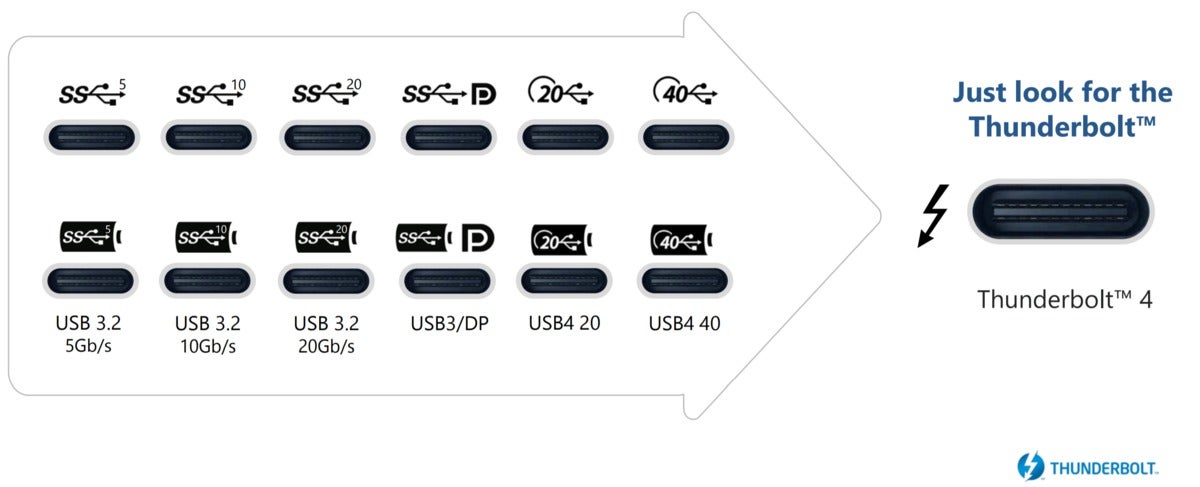 Credit: Intel
Credit: Intel
The USB Type-C connector is wonderful in many ways, but its ubiquity among modern computer interconnects has made it home to a host of confusing standards and capabilities. When you see that connector, you never know what you’re going to get: Is it USB 3 or 3.2? Maybe the upcoming USB4? What is the maximum speed? Does it have Power Delivery? Can I hook up an external display, and to what resolution? How fast is it?
Layer on top of it the Thunderbolt 3 standard and its optional specifications, and it is hard to know what to what will work with that Type-C connector and what won’t.
Intel has a new standard, Thunderbolt 4, that it hopes will help cut through the confusion. It doesn’t bring faster speeds (the maximum is still 40Gbps) or major new capabilities, but it has stricter minimum requirements and certification guidelines. The hope is that Thunderbolt 4 will be the “complete version of USB-C,” as Intel puts it.
How Thunderbolt 4 is different
In many ways, Thunderbolt 4 is the same as Thunderbolt 3. At least, it has many of the same maximum capabilities: 40Gbps throughput, 15W minimum power delivery for accessories, support for two 4K monitors, and so on. But many Thunderbolt 3 ports on PCs do not actually meet these best-case specifications, and they’re not all required for certification. Thunderbolt 4 raises the minimum requirements substantially.
 Intel
Intel
Thunderbolt 4 has similar maximum capabilities to Thunderbolt 3, but much higher minimum requirements.
You might think of Thunderbolt 4 as a sort of “guaranteed maximum capability Thunderbolt 3.”
What this means for future Apple products
While Thunderbolt and USB-C implementation has been a big mess on Windows PCs, Apple’s recent Macs have been a shining example of top-notch Thunderbolt implementation. Modern Macs tend to support the maximum throughput, eGPUs, and multiple 4K monitors on their Thunderbolt 3 ports.
But not every Apple product with a Type-C port supports Thunderbolt 3. The iPad Pro has a USB-C port and supports external displays using the DisplayPort standard, but is not a Thunderbolt port. The 12-inch MacBook, now discontinued, had a USB-C port with no Thunderbolt as well.
 Intel
Intel
Thunderbolt 4 is meant to clean up the USB type-C mess.
Will future Macs support Thunderbolt 4? The ones that are based on Intel processors probably will. Intel will introduce Thunderbolt 4 controllers in its “Tiger Lake” processors, due for release near the end of the year. Macs using those chips will probably hit the market in the first half of next year. A stand-alone Intel controller chip will follow at a later date.
Apple recently announced that it will transition Macs from Intel processors to its own silicon. That throws a bit of a wrinkle in things.
Macs that use Intel processors (there will still be some of those for the next year or two) will probably support Thunderbolt 4, once Macs with Tiger Lake processors show up. It won’t make a huge difference in practical terms—Apple’s Thunderbolt 3 implementation is usually so robust that it meets most of the Thunderbolt 4 minimum specs.
What about Macs that use Apple’s own silicon? One requirement for Thunderbolt 4 certification is “Intel VT-d DMA protection” which is a security measure that prevents memory access from connected devices. PCWorld points out that Intel says it would certify an “equivalent” DMA protection technology, though. So Apple could conceivably have its own Thunderbolt 4 controller that meets Intel’s certification process, or it could use an Intel controller chip when one becomes available in the future.
It’s possible that Macs with Apple silicon won’t have any Thunderbolt certification at all. They would almost certainly have USB-C ports with power delivery and external monitor support, but Apple may forego certain certification requirements and simply tell users what does and doesn’t work with its products. Thunderbolt support is one of the big question marks for the upcoming Macs with Apple silicon, and we currently have too many unanswered questions to know how the new Thunderbolt 4 specifications and requirements may fit into them.

















